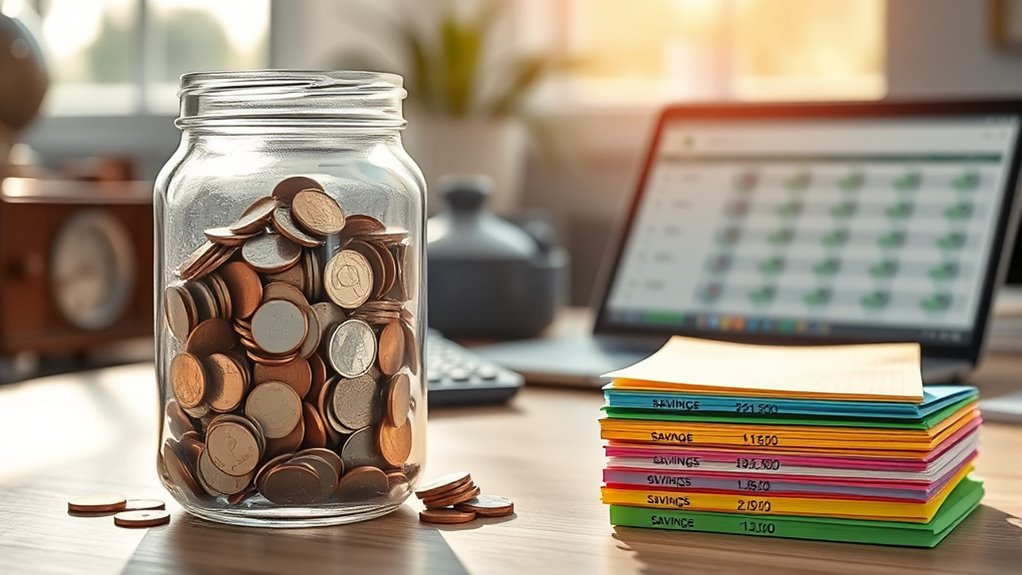Building an emergency fund is vital for your financial security. Start by determining how much you need—aim for 3 to 6 months’ worth of living expenses. Next, set a monthly savings plan by dividing your goal by the number of months you want to save. Open a dedicated, high-yield savings account and automate your contributions to stay consistent. Regularly review your fund and adjust as needed. Discover more tips on managing and growing your emergency savings effectively.
Key Takeaways
- Determine your savings goal by calculating 3 to 6 months’ worth of living expenses based on your personal situation.
- Create a monthly savings plan by dividing your target amount by your desired saving timeframe for manageable contributions.
- Open a dedicated high-yield savings account to separate your emergency fund from regular spending and earn interest.
- Automate your savings by setting up regular transfers from your checking account to ensure consistent contributions.
- Regularly review and adjust your savings goals to reflect changes in your financial situation and maintain a budget.

Have you ever wondered how much peace of mind an emergency fund can bring? Knowing you have a financial cushion ready for unexpected expenses can make a huge difference in your overall stress levels. Building an emergency fund isn’t just a smart financial move; it’s a step toward securing your future. Let’s break down how you can create one, step by step.
First, figure out how much you need to save. A common guideline is to aim for three to six months’ worth of living expenses. This amount varies based on your personal situation. Are you single, or do you have a family to support? Consider your job stability, health care costs, and any other financial obligations you have. Once you have a target amount, it’ll be easier to create a plan.
Next, set a monthly savings goal. Take your target amount and divide it by the number of months you’d like to take to reach it. For instance, if you need $6,000 and want to save it in a year, you’ll need to put aside $500 each month. This makes the process feel more manageable, and you can adjust your monthly contributions if you need to.
Now, it’s time to open a dedicated savings account. You want this account to be separate from your regular checking and savings accounts, so you’re less likely to dip into it for non-emergencies. Look for a high-yield savings account to earn some interest while your money sits there, but make sure it’s easily accessible when you need to withdraw funds.
To make saving easier, consider automating your contributions. Set up an automatic transfer from your checking account to your emergency fund each payday. This way, you won’t have to think about it, and you’ll be less tempted to spend that money elsewhere.
While you’re building your emergency fund, stay committed and patient. It might take time, but every little bit counts. If you receive a bonus or tax refund, consider adding a portion of it to your fund. This can fast-track your savings and give you an extra boost.
Lastly, review your emergency fund regularly. Life changes, and so do your financial needs. Adjust your savings goals as needed to ensure you’re always prepared for the unexpected. With dedication and a clear plan, you’ll find that peace of mind is well worth the effort.
Additionally, consider how maintaining a budget can help you track and manage your expenses effectively, making it easier to save for your emergency fund.
Frequently Asked Questions
How Much Should I Save for My Emergency Fund?
You should aim to save three to six months’ worth of living expenses for your emergency fund. Start by calculating your monthly expenses, including rent, utilities, groceries, and transportation. Once you’ve got that number, multiply it by three or six, depending on your comfort level and job stability. Having this cushion will help you handle unexpected expenses without stress, so you can focus on what’s really important when emergencies arise.
Where Should I Keep My Emergency Fund?
You should keep your emergency fund in a high-yield savings account or a money market account. These options offer easy access to your funds while earning interest, so your money grows without risking it in the stock market. Avoid tying it up in long-term investments or checking accounts that earn little interest. This way, you’ll be ready for unexpected expenses without losing any of your hard-earned savings.
Can I Use My Emergency Fund for Non-Emergencies?
You shouldn’t use your emergency fund for non-emergencies. Imagine you’ve built up a solid $5,000 for unexpected expenses. If your car breaks down, you can cover the repair costs without stress. However, if you dip into that fund for a vacation, you might find yourself in trouble when a real emergency arises. Keep your emergency fund strictly for urgent situations, ensuring you’re financially secure when life throws you a curveball.
How Long Does It Take to Build an Emergency Fund?
It usually takes three to six months to build a solid emergency fund, but it really depends on your savings goals and income. If you set aside a portion of your paycheck each month, you’ll see progress. Start with a small, manageable target, then gradually increase it as you get comfortable. Stay consistent, and before you know it, you’ll have a safety net ready for any unexpected expenses that come your way.
What if I Can’t Save Consistently for My Emergency Fund?
If you can’t save consistently for your emergency fund, don’t stress. Think of a river that sometimes flows strong and other times trickles; every bit counts. Start small—set aside even a few dollars when possible. You might also consider automatic transfers to make saving easier. Flexibility’s key; adjust your goals as needed, and remember that progress, no matter how slow, is still progress toward your financial safety net.
Conclusion
Building an emergency fund might seem intimidating, but it’s absolutely achievable with small, consistent steps. You might think you can’t spare any money, but even setting aside a little each week adds up quickly. Remember, having that financial cushion can bring peace of mind during unexpected situations. Don’t let the fear of not saving enough hold you back; every bit counts. Take action today, and you’ll be grateful for the security your fund provides when you need it most.









